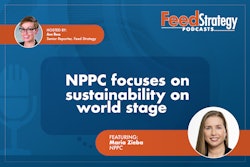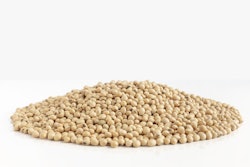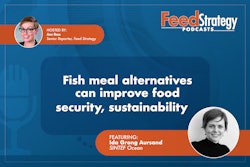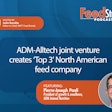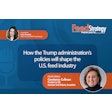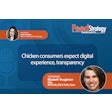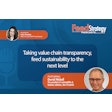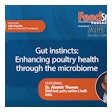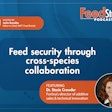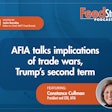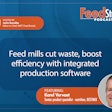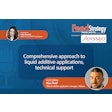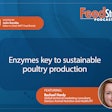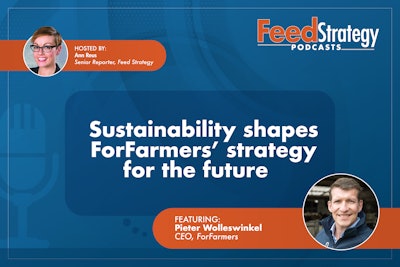
Ann Reus: Hello and welcome to the Feed Strategy podcast. I’m your host, Feed Strategy senior reporter Ann Reus.
Pieter Wolleswinkel has been CEO at ForFarmers since April. ForFarmers is the third largest feed producer in Europe and No. 16 in the world, according to Feed Strategy’s Top Feed Companies database. This year has been a period of transition for Wolleswinkel and ForFarmers, as he recently told me in an interview, and he’s looking forward to developing the company’s strategy for the future. We talked about what the future may look like and what that means for the feed industry.
Hi, Peter, thanks for being here with me.
Pieter Wolleswinkel: Hi Ann. Nice to be here.
Reus: You've been in the permanent role of CEO at ForFarmers for more than six months after an interim period before that. How has the transition been for you and the company? Tell me about some of the changes at ForFarmers during that time.
Wolleswinkel: Yeah, 2023 is for us, you can call that a transition year. We've set our strategy end of last year. So, we're now in the execution mode — that means several things. We reorganized ourselves from a central-led company into a more local-oriented company with strong local management teams. We're making choices. For example, we divested our Belgium compound feed activities, and we did an acquisition in Poland. We're focusing on our costs in this huge period of hyperinflation, and we are accelerating our sustainability journey, especially working also with chain partners to make progress within our European ambition. So, all in all, a busy agenda. But if I talk for myself, in my CEO role, it’s great to lead the company. And especially in this period of time, I think we have a great story to tell. So, I'm very happy about that, indeed.
Reus: ForFarmers is in the process of updating and reworking its vision and mission statement. What are some of the reasons behind this update, and what will be the focus in the future?
Wolleswinkel: Yeah, key thing is that, as I just said, we are working on our strategy, Strategy 2025. But we also see that we need to think long term in this period of time. There's a lot going on within Europe with regards to the food systems that we want to have towards 2030, towards 2040. So we use this period of time to have a lot of discussions with many of our senior leaders, but also other employees, with farmers to discuss, hey, what will society look like, demand towards the future? For us what clearly came out, and we recognize the need for affordable and sustainable foods. And we can play a great role in that. We truly believe that livestock farming, and farmers play a crucial role in that. And for us, it's great to have an essential role in circular food systems. So that is what our focus will be, focusing very much on today, making sure farmers have good returns, but also ensure a long-term robust income for the farmers. And we believe that the sustainability journey is a great opportunity for us in that. Lowering carbon footprint, enhancing circularity and protect biodiversity are the crucial pillars of sustainability journey. So, all in all, it was great to have these conversations with our employees. And this will help to determine our Strategy 2030, because 2025 is only one year ahead of us.
Reus: And we'll talk a little bit more about sustainability here in a minute. But first, I want to ask you, how do you define agriculture technology, and how do you see it tying into ForFarmers’ vision?
Wolleswinkel: Yeah, technology has always been the heart of our company, and I think farming as a whole. We've always been there to make progress. So on this, I can look at it from two directions. The first is we serve, within Europe, 26,000 farmers. That is what I often say, the largest research farm in Europe. We have so many data coming to us that will help us compare farmers one to another. And that helps a lot to ensure that our feeding programs help the farmers move forward. On the other side, we do see that, around sustainability, the ambition becomes more clear. And that also means that, for us, we spend much more time with regards to technology to see how can we move forward. How can we lower our carbon footprint? How can we replace conventional protein sources? That is very high on our list. So, from a technology point of view, yeah, at this point in time, we're looking both at today, but clearly also at tomorrow.
Reus: Back to the topic of sustainability, the scope of corporate sustainability is broad and includes animal welfare and reduced emissions, among many other things. How do you most commonly see ForFarmers members adopting sustainability in their operations?
Wolleswinkel: Yeah, if we look at it from those two directions, for us, it's different. If we talk about animal welfare, we often do what regulation or market parties ask from us. If I can give an example, for example, in the Netherlands, the broilers, the broiler chickens are moving more to a free-range system meaning less chicks per square meter. We need to adjust our feeding programs on that. They have different nutritional demands. So, for us, it's a good way to differentiate. On the other side, if you talk more about, for example, lowering the emissions, that's at the heart of ForFarmers. Obviously, we look at our own factories, our own logistics, but also very much at the way we use our raw materials, how we source, and with that, we spend a lot of time talking with our suppliers to see how we can improve things. With this know-how, we also have interactions with retailers, we also talk with the processors, dairy processors, slaughterhouses, to make sure we set a dot on the horizon that is feasible – feasible for the farmers, feasible for the chain, and at the end of the day, also feasible for the consumer. So based on that, sustainability is very high on our agenda.
Reus: In your opinion, what is the most important measure feed producers can adopt to improve their sustainability score, internally and externally?
Wolleswinkel: If you would force me to pick one, I would look at the carbon footprint. At the end of the day, many things come together in this figure. And it's also the hardest figure. So, for example, we often talk about circularity and circular food systems. Why do we do that? Mainly to lower our carbon footprint. So that is for us very high on our list, we look at it as at our own supply chain, but especially how we can lower the carbon footprint within the chain within meat, dairy, and eggs. So if I could pick out one, I would take this one.
Reus: What are the biggest challenges and opportunities facing the European feed industry in the next 12 months or so?
Wolleswinkel: Yeah, obviously, there's a lot going on. Geopolitics are still affecting raw material prices as we speak. So the volatility of commodities will be very high on our list. Especially if we link that to the current hyperinflation that we see, we see changing consumer behavior because of the hyperinflation. And we have quite some concerns on this, because especially the people with less income might be affected harder. So as a feed company, we need to take a crucial responsibility in this to really make sure we have the economics right of the foods and feed systems that we supply to our farmers. So, all in all, the hyperinflation causes concerns and the volatility of the commodity is there to stay.
Reus: How is animal disease such as avian influenza and African swine fever affecting your business, and how is the EU animal production sector overall responding to these threats?
Wolleswinkel: Yeah, I think you need to differentiate the animal diseases in two effects on the feed industry. Obviously, there's a direct effect, which means that if an animal disease comes by like avian influenza, the animals are culled, the barn is empty, and there's no food supply anymore. So, from our side, there is a direct effect that we see, especially around avian influenza. If we look at, for example, African swine fever, we've mainly seen an economic effect. So, for example, in Germany and Belgium, we've seen outbreaks in the past, there's export limitations, and that affected the pig prices. Luckily, at this point in time, there's no ban on that anymore. So hopefully, fingers crossed on this part, we'll be on the right direction, but especially the direct effect of culling of animals, that is quite clear, now, is there to stay. So year after year, we see sometimes more, sometimes less, that the animal disease also plays a role on the animal husbandry and number of animals within Europe.
Reus: What technologies, investments or research do you think ForFarmers and the feed industry should make today to reap the greatest benefits in the next five to 10 years?
Wolleswinkel: Yeah, alongside, it is very much about making sure that the farmers have a good return. And with that, we still zoom in on, let's call it, the conventional research, achieving more with less resources. Improving the feed conversion ratio as an example is still very high on our list. On the other side, we see that the characteristics of feed are changing. More and more co-products from the food industry are used within animal feed. Sometimes we see that new raw materials come in our direction, and that is an opportunity. We just need to make sure that we can use that. So we look for example, within our factories, can we be more flexible in the way we accept raw materials and can produce animal feed. So this is an example where we see that, by making the right investments in our factories, we are more flexible and can produce more sustainable. So, on one side, we look conventional to the way we look at the animal performance. But especially we look at this point in time on using more raw materials in our feed, we are investing in our factories. An example is that as of two years ago, we can use processed animal proteins from, for example, the poultry industry in pig feed and from the pig industry in poultry feed. And by using that, we are able to improve the carbon footprint of our feed, and that at the end of the day helps the chain. So some examples how we look at the future and where the feed industry can take a great responsibility towards the future.
Reus: All right, well, thank you so much for taking the time to talk with me today.
Wolleswinkel: Thank you.
Reus: And thank you to the audience for listening. Keep an eye out for my profile on ForFarmers, featuring excerpts from this interview, in the January/February issue of Feed Strategy magazine. I’m Ann Reus for Feed Strategy.

